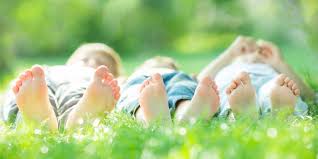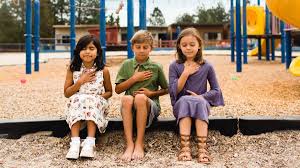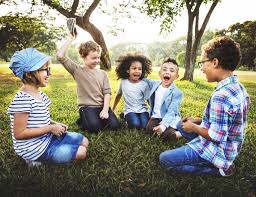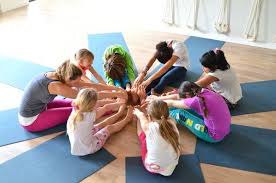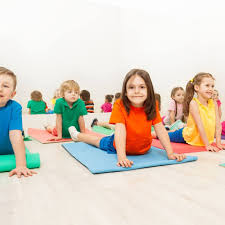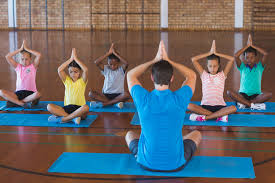Kids Yoga and Mindfulness: Q&A
Kids Yoga and Mindfulness classes are becoming more popular and with good reason. Kids from a young age struggle more and more with emotional reactivity, feelings of anxiety and worry, trouble socialising and feeling unhappy.
At RedoHealth we firmly believe that both physical AND mental health are essential for overall health and wellness.
We have been running Kids Yoga and Mindfulness classes with DeeDee for over the last year. In preparation for our upcoming term, DeeDee and Brendan sat down for a ‘Q&A style’ interview.
Check out the highlights…
What exactly is Mindfulness for Kids?
Mindfulness for kids is really no different than mindfulness for adults.
The key difference is the way in which it is delivered – particularly with the use of tapping into the imagination of kids with visualisation and games.
Mindfulness is about learning to be curious, inquiring and interested in the exact flavour and pattern of an experience without trying to alter it – wether it be pleasure, pain, joy sadness, embarrassment, headache or heart break.
Mindfulness is not about trying to relax. The sense of calm and increased clarity however is common side effect or benefit.
Mindfulness gives one the skills to learn how to creatively respond to stressful situations and relationships rather than reacting habitually. We term this ‘self-regulation’ – something both adults AND children dealing with chronic stress and anxiety are struggling with more and more.
How can parents help their child get the most out of their mindfulness practice?
To instil these habits in kids, practice is key.
Mindfulness practice should not just be used in times of stress Ideally the practice should be part of a regular daily routine, an activity just like playing outside, reading or playing the piano.
It should also be used as a way to help kids explore new sensations – pleasant, neutral and unfamiliar, not just for irritating or unpleasant situations.
Mindfulness can be used as a tool to explore kindness and curiosity.
The best way to teach kids to be mindful as a parent or caregiver is to take on the practice yourself – it is not something you can outsource, like you may do it a piano teacher or maths tutor.
Being a parent can be a stressful experience – but practising mindfulness exercises even just a few minutes a day can be extremely beneficial. It allows caregivers to both share skills of happiness and acceptance and take care of themselves at the same time.
Can you give parents and caregivers an example of a way to start a mindful practise in their day to day lives?
For parents who find themselves out of touch with the present moment, a helpful mindfulness exercise is S.T.O.P.
- Stop. Take a momentary pause no matter what you’re doing.
- Take a breath. Feel the sensation of your own breathing, bringing you back to the present moment.
- Observe. Acknowledge what is happening, good or bad, inside you or out.
- Proceed. Having checked in with the present moment, continue with whatever it was you were doing.
Is there a way families can practise mindfulness together?
One way a family can practice is at the dinner table away from the TV and phones. Take meal-time to be with your food, your breath and your body. Mindful eating is a way to explore the present moment by focus on one piece of food at time.
A great mindful eating exercise with with a sultana/raisin.
When DeeDee and Brendan sat down, she took him through a mindful eating exercise, borrowed from: http://www.recovery.awh.org.au/self-help/mindfulness/mindful-eating-exercise. See below.
🙋🏻♀️ Take hold of the sultana
👀 First look at it as if you’re a curious scientist who has never seen such a thing before. Notice the shape, the colour, the different shades of colour, the parts where light bounces off the surface, the contours, the pit where the stalk was attached
🌡Notice the weight of it in your hand and the feel of the skill against your fingers: its texture and temperature.
👃🏻 Raise it to your nose and smell it. Notice the aroma
👄 Raise it to your mouth and pause for a moment before biting into it. Bring your attention to what is happening inside your mouth: notice the salivation around your tongue and the urge to bite into it.
😋 Now slowly bite it in half, noticing your teeth breaking through the skin and sinking into the flesh and the sound that makes, and the sensation on sweetness on your tongue.
😋 Notice your teeth meeting and the feel of the sultana falling onto your tongue, and the urge to chew it and swallow it.
😁 Chew it slowly, notice the taste and texture. Notice the movement of your jaws, the sound that chewing makes, the sensation of the flesh breaking down. Notice how your tongue shapes the food.
🔔 Notice your urge to swallow – and as you do swallow, notice the movement in your throat, and the sound it makes.
😁 And after you’ve swallowed, pause and notice the way the taste gradually disappears from your tongue. Notice your growing urge to eat the remaining half.
😋 Now eat the rest of the sultana
Why is mindfulness practice so important for kids, especially in 2019?
It may surprise you, but more and more kids are struggling with mental health issues even before they hit puberty.
Anxiety, Worry. Depression. Stressed and unhappy.
Kids are struggling more than ever to make sense of what they are thinking and feeling.
Mindfulness practice gives kids a safe space to learn how to regulate their emotions and process all their thoughts and feelings.
What exactly happens in a Kids Yoga & Mindfulness class?
DeeDee’s Classes include:
👋🏻 Welcome and roll call. A chance to check in and ask how everyone is feeling.
🥵 Warm-up the body.
😮 Breath awareness practise with the Hoberman sphere.
🤸♂️Practice of sun salutations and animal poses to warm up the body, breath and mind.
🦄 Yoga adventures with a different theme and each week. (e.g. feelings, change, our impact on the environment, space, under the sea, co-operation, listening, helping others, loving yourself).
👯♂️ Yoga games, yoga partner practice.
💃🏻 🥁 🕺🏾 Free movement to live djembe drums.
😴 Savasana (relaxation) and guided meditation.
🙏🏼 Gratitude.
🧘🏽♀️ Namaste Song
🖍 Mindful colouring exercise.
Mindfulness vs Meditation – are they the same thing? What’s the difference?
Meditation typically refers to formal, seated meditation practice. There are many types of meditation:
- Guided meditation
- Loving-kindness meditation
- Breath-awareness meditation
- Visualisation meditation
- Mantra based meditation
Meditation is an intentional practice, where you focus inward to increase concentration, emotional balance and calmness.
Mindfulness is about being aware, which can include the practice of meditation.
When you are being actively mindful, you are noticing and paying attention to your behaviours, movements, feelings, thoughts and also to the effects you have on those people and environments around you.
You can practice mindfulness anywhere, anytime and with anyone by being present and being fully engaged in the here and now.
Mindfulness is the simple act of noticing and paying attention, non-judgmentally to whatever you are doing, i.e brushing your teeth, driving, eating, getting dressed.
When you are mindful, you are involved in the activity with all of your senses instead of allowing your mind to wander.
Mindfulness can be practiced both informally (at any time/place) and formally (during seated meditation). Mindfulness can be applied to any situation throughout the day.
Meditation is usually practiced for a specific amount of time.
Is Mindfulness Practice for ALL Kids?
All kids can benefit from yoga and mindfulness as it will give them skills and techniques to benefit their lives now and in the future as they experience bigger emotions, more stressful situations and relationships.
Positive effects of mindfulness practice include:
- Improved sleep
- Increased focus and concentration
- Ability to choose healthier strategies in times of stress
- Slowing down when feeling big emotions
- Ability to be proactive rather than reactive
- Using language to better communicate feelings and thoughts
- Greater empathy of people and animals
Kids yoga and mindfulness does not require any experience and kids don’t need to be flexible. It’s a non-competitive and inclusive activity that makes it ideal for every type of child.
The practice gets kids more in tune with their bodies, thoughts and feelings. It builds awareness of body and breath. Through this awareness they can learn more about how their body works and learn to slow down their racing thoughts and increased heart rate, allowing them to focus and concentrate – especially at school in the classroom.
By listening to their instincts they can learn how to communicate effectively about their experiences and feelings.
Kids with ADHD and those on the Autism spectrum (1 in 20 kids in Australia) can benefit from these practices with many of the exercises assisting kids engage with their emotions and feelings, offering them tools for self-regulation and increased self-awareness. Becoming less reactive with breath and spaciousness will offer kids the strategies they need for life, home and school.
Kids with vestibular and balance difficulties also benefit from yoga, which often involves balance on one leg, enabling the nervous system to develop improved balance skill and awareness.
What kind of changes can you expect you observe in kids through regular mindfulness practice? Speak to the team to learn to more.
#kids #yoga #mindfulness #med #mentalhealth #health
